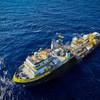Russia expressed optimism about plans for a short-cut Arctic sea route between Europe and the Pacific Ocean despite skepticism from the Russian military and some foreign shipowners.
"Of course there are problems...but we look at the future of the Northern Sea Route with optimism," Russian Transport Minister Sergei Frank said.
The seaway is almost 40 percent, or up or 4,000 miles (6,400 km), shorter than conventional routes via the Suez or Panama canals between Europe and Japan. The end of the Cold War has revived mariners' dreams of creating a commercial passage through the ice.
Frank said Russia is studying the building of a new generation of nuclear ice-breakers, used in past decades to plough a route through the Arctic for Soviet warships or cargo vessels carrying everything from nickel to farm produce.
Moscow plans to invest $11 million in its ice-breaker fleet in 2000 as part of a five-fold overall rise in spending on the route from 1999, he said. Moscow now has six nuclear- and six diesel-powered ships in its ice-breaker fleet.
Russia would also cut charges from 2000 for rental of ice-breakers to accompany cargo vessels, hoping to encourage foreign trade.
Military Doubts
Under the Northern Sea Route, ships would head east past Scandinavia, follow the northern Russian coast and then into the Pacific via the Bering Strait between Alaska and Russia's Far East.
Frank admitted that the Russian military had doubts about opening the route - the north coast of Russia would be a front line of defense against any missile attack by the U.S.
Rolf Saether, head of the Norwegian Shipowners' Association, expressed skepticism about the route's commercial prospects. "We do not think that, in the immediate future, the northern sea route will play any vital role as a new sea route influencing world trade," he said.
The first east-west passage along the northern sea route was in 1878 by a Swedish-Finnish expedition. Dutchman Willem Barents, who gave his name to the Barents Sea, died after his ship ran aground on Novaya Zemlya in 1596.
Saether said that shallow straits off the coast of Russia would restrict drafts for any vessels to 20-25,000 dwt, a third or a quarter of vessels on the southerly routes.
Additionally, thicker hulls for vessels for the Arctic would push up costs, while the route was only practical for most vessels for four to five months a year, he said. Higher risks would push up insurance costs.
Frank said growing exports of oil, combined with growing coastal traffic, would bolster use of the Arctic sea route in coming years irrespective of traffic between the Pacific and Europe.
Russia's largest oil producer LUKOIL was close to starting transport of oil from Varandey, Kolguev and Ob Bay, Frank said.
Volumes of cargoes shipped in the Russian Arctic region had tumbled to 1.5 million tons in 1999 from 6.6 million in 1987, partly due to economic turmoil and rationalization.
He forecast that volumes, bolstered mainly by rising oil output from the region, were set to jump to four million tons in 2005 and 50 million in 2020. - (Alister Doyle, Reuters)
Sponsored Content
MSC Sets a New Standard for Time Off in 2025, Plus Earn a $44,345 Bonus as an Able Seaman!

The Future of the Advanced Measurement Industry: A Vision of Precision, Safety, and Reliability

August 2025
 Read the Magazine
Read the Magazine

 Read the Magazine
Read the Magazine
This issue sponsored by:

Rethinking Crew Experience: The Next Frontier in Maritime Operations
Subscribe for
Maritime Reporter E-News
Maritime Reporter E-News is the maritime industry's largest circulation and most authoritative ENews Service, delivered to your Email five times per week









